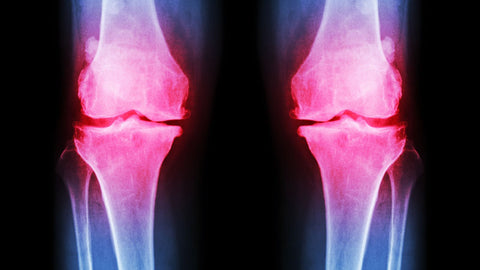How to Improve Quality of Life With Osteoarthritis
•Posted on April 08 2024

Osteoarthritis (OA) is a degenerative joint condition that affects millions of people worldwide. It's characterized by the breakdown of cartilage in the joints, leading to pain, stiffness, and decreased mobility.
While there's no cure for osteoarthritis, there are various strategies you can adopt to manage symptoms and improve your quality of life.
In this comprehensive guide, we'll explore the best treatments, self-care practices, and answers to common questions about osteoarthritis.
Recommended for You:

Understanding Osteoarthritis

What Causes Osteoarthritis?
Osteoarthritis is commonly referred to as degenerative osteoarthritis because it involves the gradual breakdown of cartilage in the joints.
Cartilage serves as a cushion between the bones, allowing for smooth movement.
Factors such as aging, joint injury, obesity, genetics, and repetitive stress on the joints contribute to the development of osteoarthritis.
Related Post: Got Arthritis? You Should Add Magnesium to Your Diet
How Osteoarthritis Affects the Joints

As osteoarthritis progresses, the cartilage wears away, causing bones to rub against each other.
This leads to pain, swelling, and stiffness in the affected joints, such as the knees, hips, hands, and spine.
Over time, osteoarthritis can impair mobility and negatively impact daily activities.
Self-Care Strategies for Osteoarthritis

Osteoarthritis Self-Care
Effective self-care practices play a crucial role in managing osteoarthritis symptoms and improving joint function.
Here are some self-care strategies you can incorporate into your daily routine:
-
Maintain a Healthy Weight: Excess weight puts added stress on the joints, worsening osteoarthritis symptoms. Aim to maintain a healthy weight through a balanced diet and regular exercise.
-
Stay Active: Regular physical activity helps strengthen muscles, improve joint flexibility, and reduce pain. Low-impact exercises such as swimming, walking, and cycling are gentle on the joints and beneficial for osteoarthritis.
-
Use Assistive Devices: Assistive devices such as braces, splints, and orthotic inserts can provide support and alleviate pressure on affected joints, improving mobility and reducing discomfort.
-
Apply Heat or Cold Therapy: Heat packs and cold compresses can help relieve pain and inflammation associated with osteoarthritis. Experiment with both to determine which works best for you.
-
Practice Good Posture: Maintaining proper posture can reduce strain on the joints and alleviate pain. Be mindful of your posture, especially when sitting, standing, or lifting heavy objects.
Recommended for You:

Osteoarthritis Treatment Options

Will Osteoarthritis Get Worse?
The progression of osteoarthritis varies from person to person.
While it's a degenerative condition, lifestyle modifications, proper treatment, and self-care practices can slow down its progression and improve symptoms.
Can I Reverse Osteoarthritis?
Currently, there's no known cure for osteoarthritis.
However, various treatment options can help manage symptoms, improve joint function, and enhance quality of life.
These may include medication, physical therapy, injections, and in severe cases, surgery.
Related Post: How to Care for Yourself With Osteoporosis
What is the Best Treatment for Osteoarthritis?

The best treatment for osteoarthritis depends on individual factors such as the severity of symptoms, age, overall health, and personal preferences.
Common treatments include:
- Medications: Pain relievers, nonsteroidal anti-inflammatory drugs (NSAIDs), and corticosteroid injections can help reduce pain and inflammation.
- Physical Therapy: Targeted exercises and stretches prescribed by a physical therapist can improve joint flexibility, strength, and range of motion.
- Lifestyle Modifications: Adopting healthy habits such as maintaining a balanced diet, staying active, and avoiding activities that exacerbate symptoms can significantly impact osteoarthritis management.
- Surgery: In cases of severe joint damage, surgical options such as joint replacement or arthroscopy may be considered to alleviate pain and restore function.
Recommended for You:

Can an MSM Supplement Help With Osteoarthritis?

Methylsulfonylmethane (MSM) is a popular dietary supplement believed to have anti-inflammatory and pain-relieving properties.
While some studies suggest that MSM may provide relief for osteoarthritis symptoms, more research is needed to confirm its efficacy and safety for long-term use.
It's essential to consult with a healthcare professional before starting any new supplement regimen.
Addressing Common Questions

Are Osteoarthritis and Rheumatoid Arthritis the Same?
No, osteoarthritis and rheumatoid arthritis are two distinct conditions with different underlying causes and characteristics.
Osteoarthritis is a degenerative joint disease caused by the breakdown of cartilage, whereas rheumatoid arthritis is an autoimmune disorder characterized by inflammation of the synovium (the lining of the joints).
Related Post: How to Use Magnesium Cream for Pain
Can I Prevent Osteoarthritis?
While it's not always possible to prevent osteoarthritis, there are steps you can take to reduce your risk and delay its onset.
These include:
- Maintaining a healthy weight
- Staying active
- Avoiding joint injuries
- Practicing good posture
- Protecting your joints during physical activities
Conclusion
Living well with osteoarthritis requires a holistic approach that combines self-care practices, effective treatment strategies, and a positive mindset.
By incorporating healthy habits into your daily routine and working closely with healthcare professionals, you can manage symptoms, improve joint function, and enhance your overall quality of life despite the challenges posed by osteoarthritis.
Remember to stay informed, stay active, and prioritize your joint health for a fulfilling and active lifestyle.
Comments
0 Comments
Leave a Comment